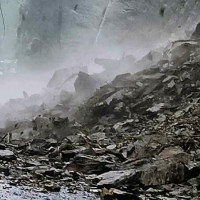- Sunday, 20 July 2025
Giant Squirrel’s Habitat Rapidly Shrinking
While walking through the forest in Hetauda, a thick, black tail was seen hanging from a high tree branch. It stood out sharply against the lighter-coloured bark and surrounding foliage. It was identified as a rare black giant squirrel indigenous to this forest habitat.
The black giant squirrel (Ratufa bicolour) has a distinctly bicoloured body with pale underparts and dark upper parts. Living in moist deciduous, semi-evergreen, and evergreen forests up to 2500 metres above sea level, these species are listed as near threatened in the IUCN Red List.
Black giant squirrels are one of the most prominent members of the squirrel family, and they prefer to stay in the middle to upper canopy of the forest, which makes them harder to spot and even harder to get a proper full-view look at. Photographing the species was equally challenging, as they often reside amidst the thick branches and leaves.
In addition to their lightning-fast reaction and agility, this species can jump from one branch to another for more than a 6-meter distance, making them a very well-adapted arboreal mammal. Most of their diet includes nuts, seeds, fruits, flowers, and tree bark, with a very occasional diet of insects.
Black giant squirrels can live up to 18 years in a captive state and are known to give birth to offspring two times a year in a large spherical nest of twigs and leaves on a tall tree. Raptors, Snakes, and ground predators are significant threats to Black giant squirrels in their natural habitat. These squirrels also steal fruits from the orchards, conflicting with humans sharing the same resources.
These mammals are rarely found in degraded or human-disturbed areas, as they require dense forests for their lifestyle. Land use change, deforestation, timber harvesting, habitat fragmentation due to linear infrastructures, etc., are causing the decline in these species habitats and populations across their home range. Some scientific study predicts that these species will lose around 97 per cent of their native habitat in India by 2050. Hunting these species for their skin, in retaliation by orchard owners and peoples, is even found to be killing these animals by misidentifying these rodents as Civets, which is not harmful to humans but yet is mistreated.
Their role in seed dispersal in the ecosystem is vital as they help keep the secondary growth of the forest from dispersing seeds of large-seeded trees through their feeding habit. Conservation of these species is critical as they are responsible for seed propagation and dispersal of large native trees of this broadleaf deciduous forest. As conserving these forests requires a multi-faceted approach, conserving these giant rodents should also be integral. Despite their sheer importance to this forest and their vulnerability, black giant squirrels are the least studied by the scientific community, probably due to their hardness to research and the limited grants available for these small animals compared to big ones. That is why very little is known about their habitat requirements that can translate to management and conservation action.
(The author is pursuing a master's in wildlife management at the Institute of Forestry, Tribhuvan University. Photos were all taken in the Tropical forest of Hetauda by the author. )















